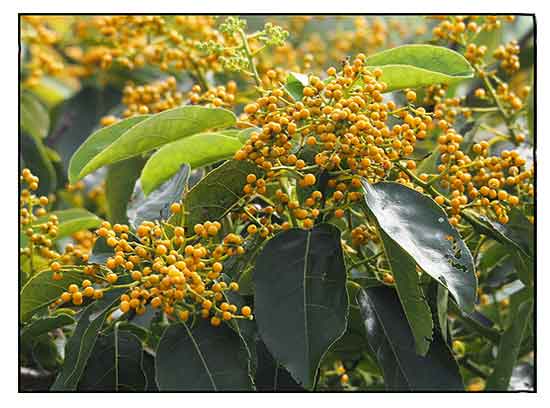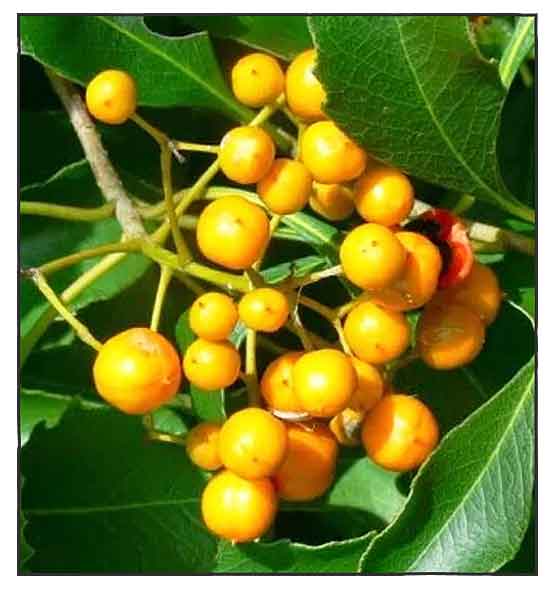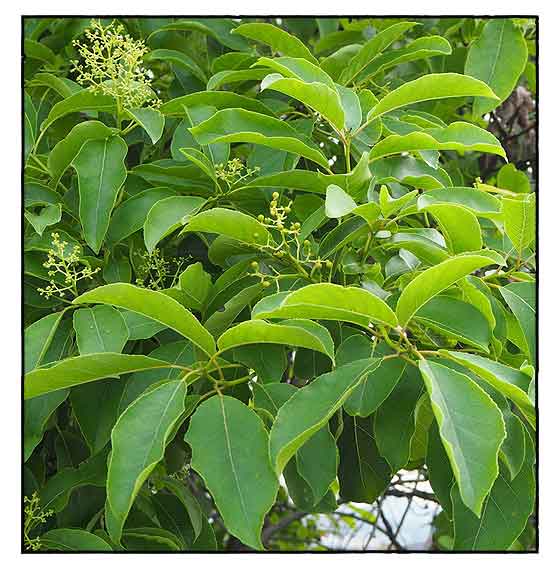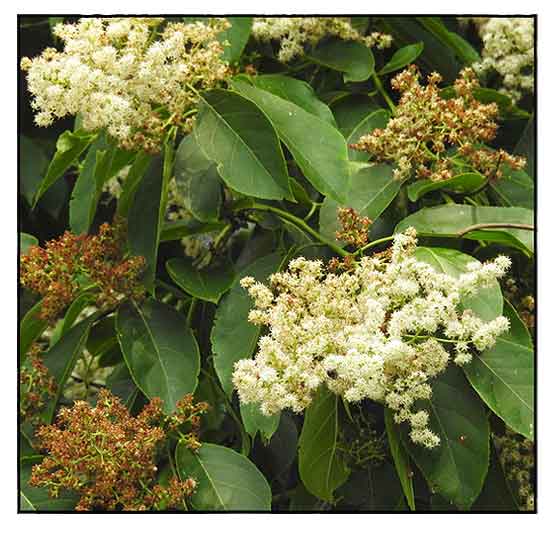 Gen info Gen info
- Ehretia is a genus of flowering plants in the borage family, Boraginaceae. It contains about 50 species.
- The genus name Ehretia honors German botanical illustrator Georg Dionysius Ehret (1708-1770). (2)
Botany
• Tree to 30 m high, often ± deciduous, mostly glabrous; bark gray, smooth. Leaves: Leaves ovate to elliptic; lamina 8–15 cm long, mostly 2.5–5.5 cm wide, apex acuminate, margins toothed, lamina glabrous, veins pinnate to arcuate; petiole 12–25 mm long. Flowers: Inflorescence a many-flowered panicle. Calyx glabrous or sparsely pubescent. Corolla c. 5 mm long and 6 mm diam., white; lobes 1.5–2 mm long. Anthers exserted. Ovary 4-locular with 1 ovule per loculus; style exserted. Fruits: Drupe with 2 pyrenes, 5–7 mm diam., orange to yellow.
 • A medium to large size tree, occasionally reaching 30 meters in height and a 90 cm in trunk diameter. Bark is of a creamy gray color, with vertical fissures. Koda is often easily identified in winter as being deciduous and of the characteristic flutings at the base of the trunk. Leaves: Leaves are alternate and simple, tapering to a tip, finely toothed, 8 to 13 cm long. Smooth and green on both surfaces slightly hairy above. The midrib and lateral veins are distinct on both sides of the leaf, raised beneath. Flowers: Flowers are white, sweetly scented, in panicles. Individual flowers are without a stalk, about 4 mm in diameter. Flowers appear in September to November in the southern hemisphere. Fruit: Fruit is a yellow or orange drupe, 4 to 5 mm in diameter, containing four seeds. • A medium to large size tree, occasionally reaching 30 meters in height and a 90 cm in trunk diameter. Bark is of a creamy gray color, with vertical fissures. Koda is often easily identified in winter as being deciduous and of the characteristic flutings at the base of the trunk. Leaves: Leaves are alternate and simple, tapering to a tip, finely toothed, 8 to 13 cm long. Smooth and green on both surfaces slightly hairy above. The midrib and lateral veins are distinct on both sides of the leaf, raised beneath. Flowers: Flowers are white, sweetly scented, in panicles. Individual flowers are without a stalk, about 4 mm in diameter. Flowers appear in September to November in the southern hemisphere. Fruit: Fruit is a yellow or orange drupe, 4 to 5 mm in diameter, containing four seeds.
Distribution
- Native to the Philippines.
- Also native to Assam, Bangladesh, China South-Central, China Southeast, East Himalaya, India, Japan, Jawa, Korea, Laos, Lesser Sunda Is., Maluku, Myanmar, Nansei-shoto, Nepal, New Guinea, New South Wales, Queensland, Taiwan, Thailand, Vietnam, West Himalaya. (1)
 Constituents Constituents
- GC-MS study of fruit essential oil yielded 30 components, 29 of which were identified, with highest content of 2,4-decadienal (37.54%), (E,E)-2,4-decadienal (20.31%), 2-(prop-2-benzyloxy) tetradecane (10%), diethyl phthalate (5.28%). (see study below) (5)
- Phytochemical screening of hydroalcoholic extract of leaves showed presence of tannin, saponin glycoside, cardiac glycoside, flavonoid, steroid, protein, carbohydrate, and alkaloid. (see study below) (14)
Properties
- Studies have suggested antioxidant, anti-inflammatory, antihemolytic, antimicrobial, photoprotective, antidiabetic, antileishmanial, antimalarial, analgesic, muscle relaxant, antispasmodic properties.
Parts used
Bark, leaves oil.
 Uses Uses
Edibility
- Fruit is eaten raw, sweet tasting.
- Unripe and mature fruit can be pickled.
Folkloric
- No reported folkloric medicinal use in the Philippines.
- Traditionally,
leaves and bark used for treatment of fever, sores on the tongue, dysentery.
-
Oil used for skin diseases and rheumatism. (2)
- Juice of bark used for fevers.
- Extract of leaves mixed with water, taken orally, once daily for 2-3 days to treat acute dysentery. Juice from bark used for fevers and to treat sores on tongue. (9)
Others
- Wood: Light, soft, tough; used for carrying poles and building furniture.
- Fuel: Wood used for fuel.
- Fodder: Leaves used as fodder for livestock.
- Agroforestry: Used as erosion controller in farm forestry.
Studies
• Antioxidant / Anti-Inflammatory / Antihemolytic / Photoprotective / Fruit Essential oil: Essential oil of E. acuminata fruit was evaluated for antioxidant, antidiabetic, anti-inflammatory, antihemolytic, photoprotective, and antimicrobial activity. Fruit EO yielded highest DPPH radical scavenging activity at concentrations ranging from 25 µg/mL to 1000 µg/mL. In vitro α-amylase inhibitory activity showed IC50 of 40.81 µg/ml, which reflects obstrusive inhibitory activity. The EO also showed noticeable α-glucosidase inhibitory activity with IC50 of 285.67 µg/mL. The EO showed concentration-dependent inhibition of protein (albumin) denaturation at concentration range of 50 to 2000 µg/mL. EO also showed substantial antihemolytic potential and photoprotective activity with SPF in the range of 21.17. The EO was also shown to be effective in suppressing microbial growth of food poisoning bacteria (Gm+ Listeria monocytogenes and Staphylococcus aureus and Gm- Escherichia coli and Pseudomonas aeruginosa) with variable potency at concentration of 25 mg/ml. (see constituents above) (5)
• Antioxidant / Bark: Study evaluated different bark extracts of E. acuminata for free radical properties using ascorbic acid and gallic acid as standard antioxidant. Free radical scavenging activity was evaluated using DPPH, ABTS, FRAP, and nitric oxide assays. Antioxidant activity was strongest in ethyl acetate and weakest in the water extract. EA IC50 ranged between 22 and 140 µg/ml compared to ascorbic acid at 28 µg/mL. The ABTS showed high reproducibility, was simple and rapidly performed, and had highest correlation with both ascorbic acid and total phenolics. (6)
• Antidiabetic / Anti-Inflammatory / Bark: Study evaluated the antidiabetic and anti-inflammatory activities of E. acuminata bark extracts by α-amylase and α-glucosidase inhibition method. Anti-inflammatory activity was assessed using egg albumin of hen. The ethyl acetate and ethanol extract showed significant anti-inflammatory effects (IC50s 170 and 172 µg/mL respectively). Only the chloroform extract showed significants antidiabetic effect (IC50 42-45 µg/mL). (7)
• Antileishmanial / Antiplasmodial / Cytotoxicity / Leaves: In a study of selected plants of Nepal, a methanol extract of leaves showed antiprotozoal activity (IC50- 54.5 µg/ml, SI 0.9), anti-Plasmodium falciparum activity (IC50 12.1, SI 4.2), and cytotoxicity against MRC-5 cell lines (CC50 5.0.5). (9)
• Analgesic / Muscle Relaxant / Antispasmodic / Bark: Study evaluated the pharmacognostic potency of bark extracts from E. acuminata in four activities, i.e., analgesic, muscle relaxant, antispasmodic, and acute toxicity. The distilled water bark extract showed significant dose dependent analgesic activity (p<0.001) on acetic acid-induced writhing in mice. The extract showed significant dose dependent muscle relaxant potential. The distilled water bark extract showed significant dose dependent antispasmodic activity (p<0.05). (10)
• Antidiabetic / Anti-Inflammatory / Antihemolytic / Antimicrobial / Leaves: Study evaluated crude extracts of E. acuminata leaves for antidiabetic, anti-inflammatory, antimicrobial, and antihemolytic activities. Highest antidiabetic activity was seen in the chloroform extracts (IC50 260-265 µg/mL). In anti-inflammatory assay, the ethyl acetate extract showed highest potential (IC50 290 µg/mL). The ethanol extract showed highest zone of inhibition (12-18mm) with different food poisoning microbes. The EA extract showed highest antihemolytic potential with IC50 90 µg/mL. (12)
• Silver and Copper Nanoparticles / Antibacterial Fabrics against Nosocoial Infections: Study focused on a sustainable approach for green synthesis of silver and copper nanoparticles, and the effect of extracted phytochemicals on cotton fibers, and the development of durable antibacterial fabrics with the copper and silver particles firmly attached to the fabric surface. Coated cotton fibers were investigated for antibacterial, antiviral, and antifungal properties. All particles showed excellent reduction percentages while the phytochemicals showed no activity. Overall strongest antibacterial effect was found on fabrics coated with green synthesized copper particles with ZOI 5mm and quantitative reduction of 99.99%. The developed antibacterial fabrics can be applied in the field of hospital textiles i.e., fabrication of antibacterial surgical gowns, panel covers, bed sheets, coveralls, curtains, chair covers, etc. (13)
• Topical Ointment and Gel Formulations / Leaves: Study reports on the preparation and evaluated the topical dosages of ointment and gel formulations from E. acuminata leaves extracts, in measures of physicochemical parameters viz., pH, viscosity, washability, spreadability, rate of drug release, rheological properties, etc. Formulation F1 and F3 for ointment and gel, respectively, was found stable, safe, and efficient.
Availability
Wild-crafted.
|

![]()




 • A medium to large size tree, occasionally reaching 30 meters in height and a 90 cm in trunk diameter. Bark is of a creamy gray color, with vertical fissures. Koda is often easily identified in winter as being deciduous and of the characteristic flutings at the base of the trunk. Leaves: Leaves are alternate and simple, tapering to a tip, finely toothed, 8 to 13 cm long. Smooth and green on both surfaces slightly hairy above. The midrib and lateral veins are distinct on both sides of the leaf, raised beneath. Flowers: Flowers are white, sweetly scented, in panicles. Individual flowers are without a stalk, about 4 mm in diameter. Flowers appear in September to November in the southern hemisphere. Fruit: Fruit is a yellow or orange drupe, 4 to 5 mm in diameter, containing four seeds.
• A medium to large size tree, occasionally reaching 30 meters in height and a 90 cm in trunk diameter. Bark is of a creamy gray color, with vertical fissures. Koda is often easily identified in winter as being deciduous and of the characteristic flutings at the base of the trunk. Leaves: Leaves are alternate and simple, tapering to a tip, finely toothed, 8 to 13 cm long. Smooth and green on both surfaces slightly hairy above. The midrib and lateral veins are distinct on both sides of the leaf, raised beneath. Flowers: Flowers are white, sweetly scented, in panicles. Individual flowers are without a stalk, about 4 mm in diameter. Flowers appear in September to November in the southern hemisphere. Fruit: Fruit is a yellow or orange drupe, 4 to 5 mm in diameter, containing four seeds.  Constituents
Constituents Uses
Uses